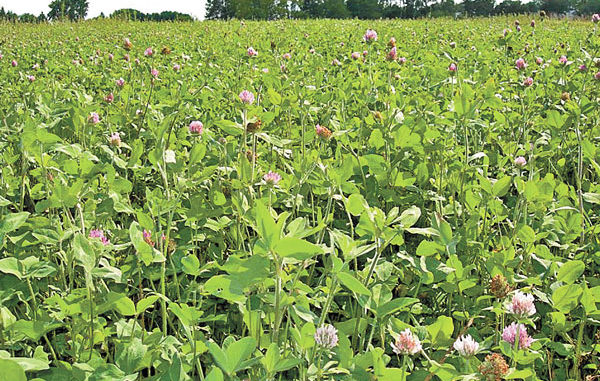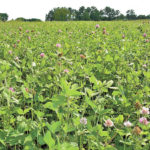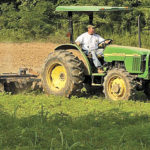
Cultivating a rich stand of clover will pull deer from afar to feast on this magically delicious legume.
Clover is nothing less than deer candy with a nutritious kick. Boasting between 18- and 35-percent crude protein, depending on variety, thick clover stands offer prime nutrient supplements for deer, turkey, and other wildlife. Not only do deer love clover, hunters around the Carolinas quickly get excited when their plots get pounded by the entire local deer herd.
As soil temperature falls and the winter rains persist in October, conditions become optimal for establishing new stands of clover.
Wildlife just love clover. Every food-plot program should include at least one stand of clover. The variety of clovers on the market allows wildlife managers to grow thick and healthy stands of wildlife forage under variable climatic conditions. The majority of natural soils throughout the Carolinas are on the acidic side, and luckily, clovers are more tolerant of acidic soils than many other food plot seed.
Hunter Todd Ramsey is a firm believer in food plots, with clover varieties ranking at the top of his list.
“No. 1, the deer love it, and it is available as a food source throughout the year,” said Ramsey, a bowhunter who concentrates his efforts on cultivating food plots.
Ramsey arrowed the fifth largest-typical buck ever killed with the bow in North Carolina back in 1994 — it scored 160-3/8 — and he continues to try and top his near-record kill by cultivating nutrient-rich food sources and letting even big bucks walk. While Ramsey plants several food-plot seeds throughout the year, he allocates a substantial ratio of clover within his plots.
“Clover is rich in protein and contains high concentrations of essential micro-nutrients for building antler mass,” he said “Not to mention, clover is a preferred food source by many other species of wildlife, as well.”
In order for food plots covered in clover to become significant for a deer herd, substantial acreage must be cultivated. As a rule of thumb, one to two percent of the total land cover should be under food-plot cultivation. But hunting lands adjacent to agriculture fields with rotations of peanuts, sweet potatoes, and soybeans have less of a need to produce that one to two percent. The bottom line is, clover plots are a nutrient-rich food reservoir and a prime hunting locale.
All of Ramsey’s food plots serve two purposes. He incorporates his food-plot acreage in multiple small plots for several reasons. For starters, as a bowhunter, larger plots complicate his plan to get big bucks within archery range by sheer size alone. And since he is strictly a trophy hunter, Ramsey locates his plots to draw mature deer during daylight hours.
“Small plots, a half-acre or less, are preferred and should be placed adjacent to tight cover,” he said. “Mature bucks seem to shy away from larger plots — at least during the daylight hours anyway. Smaller plots are easy to manage and can produce a lot of forage for deer.”
Clovers are split between two main categories: perennial and annual varieties. All clovers have the ability to produce seed and a second crop, but many of the clovers classified as annuals fail after one season from competition and climatic factors.
Both clover categories offer deer and other wildlife with rich nutrition. Annual clovers predominantly serve as a fall to winter attractant and food source, having little effect on antler growth since its unavailable during early summer. Clovers prefer temperate, moist conditions to thrive. Hot, dry summers slow the growth of most varieties.
Typically, perennial clovers grow well during spring to early summer and fall to early winter. Perennial clovers provide deer with the necessary nutrition in spring and early summer for lactating fawns and bucks developing antler mass. Their fall growth spurt coincides with harsher weather conditions, as well as the deer season. But annual clovers are aggressive, quickly producing large quantities of rich forage in a short time. Annual varieties are also more tolerant of sandy soils, dry conditions, low pH and areas prone to severe weed invasion.
Annual clovers, such as: Crimson, red, and arrow-leaf are good for mixing with other cool-season seed to provide an attractive mix for the herd. Ramsey mixes oats and cow/winter peas with Crimson or red clover.
“This annual mix is very good for new food plots where the pH is still on the acidic side,” he said.
Crimson is commonly over-seeded in warm-season pastures to provide forage for cattle during winter months; consequently, crimson clover is less expensive than many of the other clovers produced primarily for wildlife uses.
Chicory is a good complementary forage to be mixed with annual or perennial clovers. The nitrogen-fixating quality of clover will fuel chicory’s need for nitrogen, fueling its growth. Although generally planted in spring, early fall plantings can persist and provide deer with a high protein food source — around 30 percent — throughout the winter as combined with clover. Heavy grazing on chicory also stimulates its growth, providing a variety of abundant foods for wildlife over the winter.
Perennial clovers are typically the white variety of clover such as, durana and ladino, which can last up to four years. But white clovers nearly require a balanced pH to thrive. Soil treatments with lime are usually needed several months before planting. But if prepared, planted, and maintained effectively, white perennial clovers offer wildlife with long-term benefits up to four to five years in some cases.
The Whitetail Institute’s Imperial Whitetail Clover was the first clover produced and mixed specifically for deer, and it is also a perennial, ladino-type clover. The Institute took a variety of clovers, and through years of cross-breeding to express ideal traits, came out with a premium variety consisting of Advantage ladino and Insight ladino clovers. Their hybridized mixture was developed to resist drought, temperature extremes, and to provide availability year-round for up to five years.
Whether planted as a single seed or mixed together with other varieties of clover or forage crops, clover provides one of the best wildlife-beneficial and attractive food plot seeds available for wildlife managers throughout the Carolinas.
Planting clover
Planting clover is no different from many other seeds planted for wildlife or agriculture use. Soils must be tested in summer for pH; typically, soils in the Carolinas have a pH value of less than five, leading to supplemental treatments of lime to raise pH.
Lime treatments should be at least 45 to 60 days before planting to allow the lime to dissolve and blend with the soil. The product labels list recommended pH ranges for the variety of clover intended for planting, but generally pH needs to be between 5.5 and 7.
All clover and other legume seed must be inoculated prior to planting. Although most commercial seeds come with a pre-inoculated coating, innoculant can be purchased at a seed store for treatment. Innoculant is a live nitrogen-fixing bacteria that binds to the clover’s roots and builds a symbiotic relationship to draw elemental nitrogen from the air and converts it to a usable form.
One of the most-common problems with food plots and clover production is competition from weedy invaders. Pre-planting herbicide applications before planting can help kill unwanted weeds, but herbicide treatments can be pricey. Again, over years of trials, Todd Ramsey avoids costly herbicides by a dual discing treatment. “Summer weeds can be such a nuisance at the end of there growth cycle,” he said. “I disc plots twice to knock back weeds, 30 days prior to planting and on planting day.”
After discing, Ramsey drags a 6×6 section of chain-link fence to prepare a level seed bed and spreads approximately three to six pounds of seed per acre. Then, he drags the seed bed one more time, intending to cover seed lightly. “White clover varieties, particularly, have a real small seed and only need around an eighth of an inch or less of soil cover,” he said.
Just as with any planting for agriculture or for a prime deer stand, fall clover plantings are vulnerable to weather conditions and much needed precipitation. Newly-planted seeds require a rain event for germination. Try to schedule planting just before a forecasted shower. Successful food plots require planning and proper techniques to create the wildlife mecca soon to become from the acres of clover sprouting from the earth.






Be the first to comment